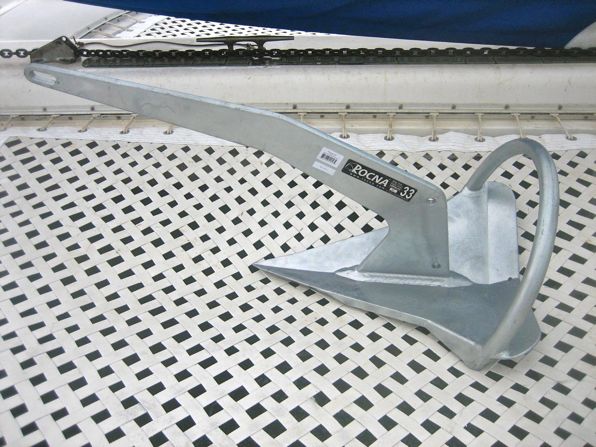All moorings are not equal
When cruisers use the word mooring, they are typically not thinking of it in the more general sense as in “a place where a ship is tied up or docked.” They are more commonly referring to a permanent fixed anchor that has been deployed at some point previous which a boat can be attached to.
In most situations we prefer to use our own ground tackle as opposed to picking up a mooring for the following reasons:
- We can see and inspect our anchor and rode easily and thus know that it is not damaged.
- Using our own anchor is FREE where as using someone else’s mooring generally is not.
There are some potential benefits to using a fixed mooring though:
- There is less damage done to the seabed, important in fragile areas. In some cases, often in marine parks, anchoring is not even permitted and you must use a mooring because of this.
- The technique for picking up a mooring is significantly easier than anchoring. I assume this is why we more often see charter boats on moorings and not anchored.
- Because of the reduced scope of the mooring line when compared to a typical anchor rode, the boat swings in a smaller circle and thus more boats can be tucked into a bay if they are on moorings instead of being anchored.
- Sometimes the holding in an anchorage is notoriously bad and thus a mooring is a more secure option. Such was the case we felt in St. George’s.
- If you are in a location with foul water, picking up a mooring allows you to keep your anchor rode clean. We opted to do this in Luperon, DR.
- If they are very good moorings they could be stronger and resist dragging in bad weather better than many anchors.

Warderick Wells in the Exumas is one example of a place where
you are required to take a mooring and not anchor.
The challenge is, how do you know if it’s a very good mooring? Unless you set the mooring yourself, the only way to really know is to dive on it and inspect the gear with your own eyes. And even if you did set the mooring yourself, it still warrants diving on it from time to time because the gear will degrade over time. Here are some examples of not-so-secure moorings:
- While out snorkeling in our dinghy, we tied to one of the mooring balls off the west coast of Carriacou. Just for kicks, I dove down to see what we were attached to. What I found was a couple feet of a sand screw sticking up out of the seabed but bent at a very acute angle. It also looked to be moving a bit when I pulled on it. Pretty sure it was not supposed to be like that. Sure glad ZTC wasn’t tied to it.
- Our friends’ boat in next door Mt. Hartman Bay pulled two sand screws out of the bottom and ended up in the mangroves.
These are just a couple of recent examples. We have heard of many moorings failing, which is why I said that I prefer using our own ground tackle that we can see and inspect.
Note: We spoke with one couple who had set their own mooring. They told us that the mooring lines/chain will degrade faster when not in use so to prevent this, they ask a boat to pick up and use their mooring when they are going to be off of it for an extended period of time.

Not my image but one I found on the net of two divers setting a sand screw in the bottom.

Nice shiny shackles and chafe gear on a mooring we took in Puerto Rico.
So, how does one “pick up” and attach to a mooring? We have a bit of a funny story about this. On the first day that Rebecca and I decided to go out and anchor our boat by ourselves, we ended up botching our first attempt. There was a lady on the shore who saw what transpired and called out to us that we were welcome to use their mooring, just off from where we were located. We said thank you and circled away to regroup but because neither Rebecca nor I had ever picked up a mooring before, we broke out our iPhone and Googled “how to pick up a mooring.” Funny stuff in retrospect. You can read about that experience here.
Our strategy for picking up and securing to a mooring is to have a dock line ready off each bow cleat. As I motor up to the float marking the location of the mooring, heading up wind (or up current if there is a strong current present), Rebecca will be ready with a boat hook to pick up the “pennant,” the line attached to the mooring ball, floating in the water. We first try to simply get one line looped through the pennant and then fed back to the same cleat, securing the boat. Once that is done, it is typically no effort at all to pull the pennant back in by hand to do the same with the line attached to the other bow cleat. Using two lines like this is MUCH superior to simply running one line through the pennant and back to the opposite cleat because a) a singe line can chafe through as the boat moves around and b) there is added safety in the redundancy of using two lines as opposed to one. Redundant safety systems are good!

The wrong way to attach your boat to a mooring (note single line run from starboard to port. In our defense, this was the first time we had ever done this.

The correct way, with two lines fed through the pennant, each led back to their respective cleats. Note that I’m out swimming while Rebecca is working out.

Our friends’ new massive Rocna, two sizes bigger than ours. This would make a nice mooring for us!


I really like your idea of using two separate lines for attachment to the mooring pennant. Redundancy is always such a good idea and especially so when the security of your vessel is dependent on this single connection.
Agreed. It is also easy enough to cast off from the mooring because both lines are fed back to the boat. They can simply be released one at a time and pulled back on board.
How do you know whether you are allowed to anchor, or if you must pick up a mooring? What if there aren’t any unused moorings? Does everywhere have a harbour-master to regulate all this?
Mike
Information like this is generally explained in cruising guides. We have a book like this for each of the areas we cruise in (see our RESEARCH page for links to the guides we carry). In places where you are required to take a mooring there is generally someone who will come around and check and collect money. If there are no balls available you are sometimes permitted to anchor outside the mooring field, typically further away from shore.
I recall the first time I picked up a mooring; it was in the Gulf Islands off of the coast here in B.C. I was 23.
I was on the bow with the boat hook, laying down because it was a long reach, and as we motored slowly up to the tire (instead of a ball) I hooked it. It was too heavy for me to bring up to the bow and so, as my husband put the boat in neutral and ran down from the command bridge, I hung on to the boat hook for dear life as the current started to drag us backwards away from the mooring. I began to slide forward and off of the deck. I did not want to let go of the hook as that would mean we would lose it. I was yelling at him to hurry as I continued my slide off of the deck. He got there just in time to grab me from falling overboard and then he grabbed the hook and pulled the tire up. My arms nearly came out of their sockets from the exertion.
I never did that again.
There are some tricks to make that easier. Even our first attempt (with a tire mooring) was tough.
Very well written. Thanks for the info
Thanks Diane!
Thanks for the great “how-to” on moorings. We’ve not yet done this and your info will be a great help. Like the idea of using two lines.
My husband and I always snorkel over the anchor or mooring. We have seen some very good moorings in the leeward isles. The moorings were essentially huge concrete pyramids with iron loops at the top. Makes you sleep well at night!
Definitely a good idea. We almost always dive on the moorings too. In some situations, the mooring base is too deep for us to check. We can always see the condition of the pennant and tackle though.